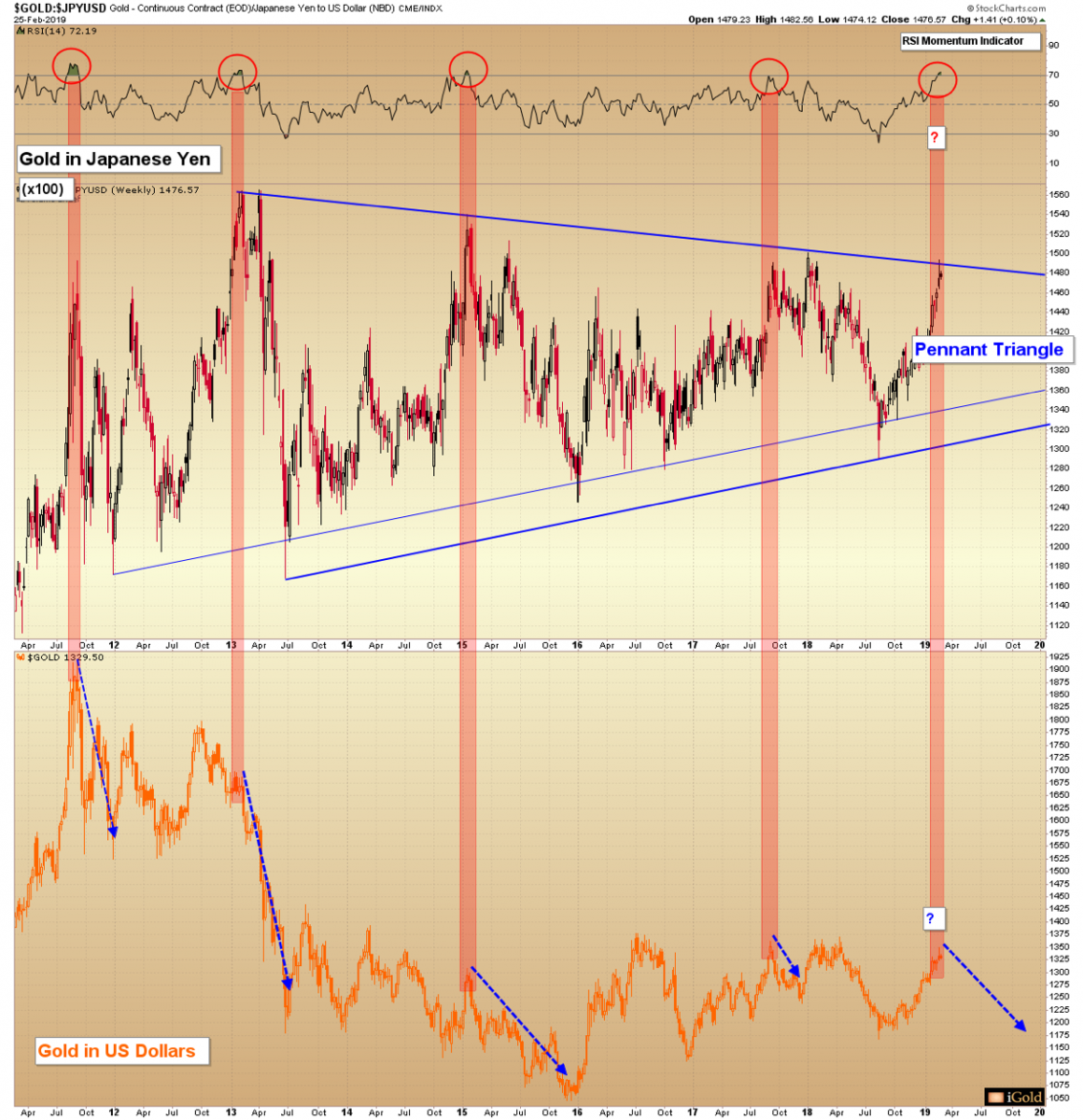Gold Price Forecast: A Warning Signal From The Far East

The gold price has been strong recently, having risen over $180 from the August 2018 low of $1,167 to the peak above $1,347 as of last week.
There have been solid fundamental reasons for gold’s run: primarily, the Federal Reserve last month hinted that it may not continue raising interest rates, as it had been assuring it would over the past three years. Such in turn has been considered a sign that the Fed may in fact reverse course and begin cutting rates later this year, which is generally considered negative for the value of the dollar and positive for precious metals.
However, are these fundamentals enough to keep bullion’s run alive? Will this market narrative continue going forward?
A Rare Warning Signal
Despite the recent performance, one of our proprietary technical indicators is flashing a major warning signal for those who follow the language of the charts. Specifically, gold is showing a sell signal witnessed only four times over the past eight years. This warning signal coincided exactly with the absolute peak in gold at $1,923 in September, 2011. This same signal appeared again in January 2013, immediately before gold fell $500 from $1,680 down to $1,180 over just six months.
So reliable has this signal been, that it has never occurred without gold falling at least $130 over the subsequent six months.
What is this signal we are referring to?
An overbought momentum reading for gold as priced in Japanese yen.
Below we show the chart which contains the warning signal; discussion follows.
Gold in Japanese Yen vs. Gold in US Dollars
The chart above contains three parts, labeled here from bottom to top:
-
Bottom - gold as priced in US dollars
-
Middle - gold as priced in Japanese yen (x100) (gold/JPY)
-
Top - relative strength index (RSI) of gold as priced in Japanese yen
RSI (top of the chart) is a study of momentum. In general, when the momentum of a market becomes too strong in one direction, this tends to represent an unsustainable trajectory. A reversal in the opposite direction will usually follow within several weeks.
Momentum of Gold Priced in Japanese Yen
The RSI momentum reading of gold as priced in Japanese yen (gold/JPY), shown at the top of the chart has now registered just its fifth weekly overbought reading since 2011. This is shown by the RSI reading above 70, highlighted with red circles.
If one follows the circled RSI readings down to the corresponding price for gold in US dollars, it is clear to see: overbought readings for gold as priced in Japanese yen have always resulted in significant multi-month or multi-year tops for gold as priced in US dollars.
Note how at the far left highlight, this signal corresponded with the exact peak for gold in September, 2011 at $1,923 per ounce.
Next, this same overbought signal coincided with the $500 decline beginning January, 2013. Next, the $275 decline starting January 2015, and finally the $130 decline starting September, 2017.
At this very moment this exact signal is flashing for a fifth time in eight years. Will it be correct again?
As market technicians, we know that there are never certainties when making projections – only probabilities.
Yet at a 100% success rate over the past eight years, this is a strong probability.
What Does This Mean for Gold Investors?
When a topping indicator that has never had a false signal appears on the gold chart, investors should take notice.
Should one sell all their gold and look to buy it back several months or years later?
Of course, no single plan will fit all investors.
Selling physical gold with the hope to re-buy it $100 or $300 lower carries the added transaction costs of premiums, taxes, and shipping.
For those who are on a regular accumulation program for physical gold and with other diversifying assets, simply waiting several months to see if this signal indeed confirms valid may result in better buy points.
However, for those using leverage, such as futures or options traders, and for those with high exposure to the gold mining sector, protective measures should be considered.
Unleveraged short positions in the GLD or GDX ETF can work well to mitigate losses in other holdings.
Put options can also be beneficial as protection; however, put options always have a time decay effect, and the purchaser must choose an appropriate strike date far enough into the future to ensure the options remain valid to capture any decline. The risk with puts is that the pending decline in gold may be slow and grinding in nature, in which case the puts could expire worthless, even if the metal declines for 6 – 12 months.
Takeaway on Gold’s Warning Signal
This signal has appeared a total of four previous times over the past eight years, and each time it has corresponded to a multi-hundred dollar decline in the price of gold over 6 – 12 months following.
It is suggested that precious metals investors consider waiting for lower prices as we observe how this signal plays out. Those using leveraged forms of investment should consider more targeted protection.
*********



















